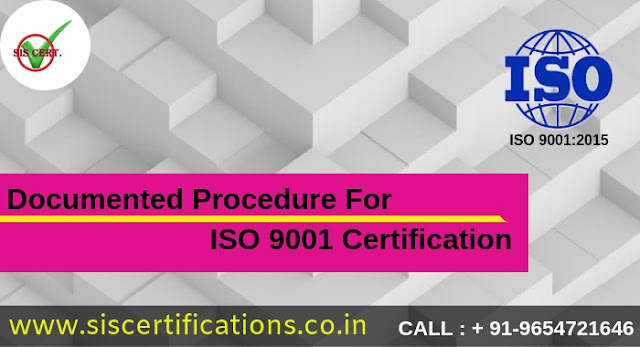HOW TO IDENTIFY RISK CONTROLS IN ISO 9001 CERTIFICATION ?
Recognizing
and executing controls is a basic advance in hazard based reasoning for the ISO 9001 Certification quality administration framework (QMS). In a past article,
How to distinguish chance centrality in ISO 9001 Certification, we took a
gander at the need to evaluate how huge a hazard is before deciding controls.
With each hazard you have distinguished you should survey the seriousness of
the issue should the hazard occur. You likewise need to consolidate this with
the appraisal of how likely the issue is to happen and whether it is
conceivable to identify the issue. By consolidating the numbers alloted to
these properties you get the Risk prerequisite Number (RPN) from the Failure Modes
and Effects Analysis (FMEA). This will push you to reliably decide the
essentialness of each hazard you have distinguished for your QMS.
To make
chance based reasoning work for your association, you will need to make your
hazard controls coordinate your hazard hugeness.
6 risk strategies for a standard control structure
Subsequent to
figuring out which dangers are huge what do you do? You will need to figure out
what controls to set up for each hazard, yet how would you do this? The mystery
is to utilize the hazard centrality to choose what dimension of control is
required. This is likely best comprehended as a standard control structure that
utilizes six different ways to oversee dangers, as characterized in Note 1 to
Clause 6.1 of ISO 9001:2015 (ISO 9001 Certification). The following are the six
hazard systems, clarified with regards to the QMS chance appraisal:
Retaining danger by educated choice: For insignificant-risks, some of the time the best system is
to simply acknowledge the hazard and continue. On the off chance that an issue
has an exceptionally low possibility of occurring, or isn't serious on the off
chance that it occurs, at that point deciding to simply respond to the issue
should it happen can be the best choice. This can likewise be the situation
when a conceivable evasion measure is excessively expensive or tedious to merit
the assets it would take to execute.
Avoiding danger: For huge dangers you may make a move
to keep the hazard from occurring, or at the end of the day: change the
opportunity of event. This could be an improvement in a procedure, supplanting
old gear with better hardware, or changing a structure to evacuate a part that
is causing a hazard. The key is that once the evasion activities are finished,
the hazard never again exists.
Eliminating the hazard source: One method for evading the hazard is
to kill the hazard source. This may include changing a section utilized in a
get together, or evacuating a procedure step that is dangerous and supplanting
it with one that does not have the hazard.
Sharing the hazard : Sometimes you can exchange a hazard
somewhere else, for example, having a procedure done by a specialist provider
as opposed to doing it without anyone's help. Another method for exchanging
hazard is through having protection set up that would give the important extra
assets to manage an issue in the event that it occurs.
Changing the probability or outcomes : Putting in managerial controls,
preparing, or extra reviews are instances of moderation of the hazard. You are
not preventing the hazard from occurring, yet you are expanding your odds of
distinguishing the issue after it happens. This relief frequently incorporates
having plans set up to manage the results of the hazard once the issue has
happened. These plans can incorporate such things as revising items or systems
to restore a procedure to an adjusting state. The hazard still exists, yet you
have activities and plans set up to decrease the hazard results.
Taking danger so as to seek after a
chance : We have
discussed dangers in the terms of having a negative outcome, yet consider the
possibility that going out on a limb can be an open door for your association.
In these circumstances, you are surveying the hazard as far as what you have to
do to profit by the chance and make a move to get it going. At the point when
this is your arrangement, you are abusing the dangers so as to profit by long
haul additions to your association.
How would you execute controls once they are identified?
One basic component
of hazard control is to guarantee that any moves that you make are consolidated
into your QMS forms. Improved procedures, or even new gear, are not powerful if
the general population utilizing them are not completely prepared in how to use
these upgrades.
Alleviation
plans should be known and comprehended by those workers will's identity
expected to utilize them with the goal that your hazard relief activities are
done in an auspicious way instead of attempting to prepare everybody once the
issue has occurred. Your controls need to wind up some portion of your regular
procedures, as opposed to an additional movement that is out of the picture and
therefore irrelevant.
Use hazard centrality to make chance control work for you
Remember,
ensure that you don't go over the edge on setting up controls for dangers that
are not imperative. This is the basic mix of seeing how you choose what chance
controls are required for the dangers you have distinguished. By handling
critical dangers with satisfactory controls, and enough joining those controls
into your QMS forms, you will find that you can utilize hazard based reasoning
to improve the procedures inside your QMS to improve them react do your
necessities stuck in an unfortunate situation. All things considered, this is
the purpose behind hazard based reasoning in the QMS.
Note : SIS Certifications Pvt. Ltd. is providing ISO Certifications in India at the best price. we are best ISO Certifications Bodies in India. we provide ISO 9001, ISO 14001, ISO 22000, ISO 27000, ISO 45001 , Kosher, Halal according you customer domain.




Comments
Post a Comment